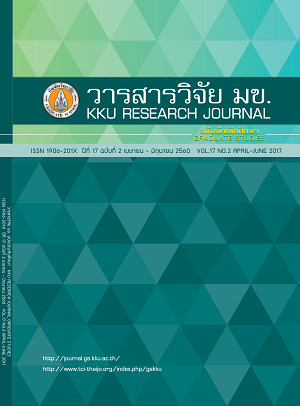การหาสภาวะที่เหมาะสมในการฉีดล้างด้านหลังตะแกรงของเครื่องเหวี่ยงแยก เพื่อลดการสูญเสียแป้งมันสำปะหลัง (Optimization of Back-Washing Condition for Centrifugal Extractor to Minimize Cassava Starch Loss)
Keywords:
การออกแบบการทดลองแบบบ็อก-เบห์นเคน (Box-Behnken design), เครื่องเหวี่ยงแยก (Centrifugal extractor), แป้งมันสำปะหลัง (Cassava starch), การฉีดล้างด้านหลัง (Back-washing)Abstract
แป้งมันสำปะหลังที่เกิดการสูญเสียแป้งไปกับกากระหว่างกระบวนการโม่เปียกในอุตสาหกรรมแป้งมันสำปะหลัง โดยส่วนใหญ่ของการสูญเสียนี้เกิดขึ้นในส่วนของเครื่องเหวี่ยงแยก ที่มีการอุดตันของรูตะแกรงที่ใช้แยกแป้งและกากออกจากกัน การทดลองถูกออกแบบโดยใช้วิธีบ็อก-เบห์นเคน (Box-Behnken) และหาค่าสภาวะที่ทำให้ค่าร้อยละการสูญเสียแป้งต่ำที่สุดโดยใช้วิธีพื้นผิวตอบสนอง จากผลการทดลองสามารถทำนายสภาวะการทำงานที่เหมาะสมของการฉีดล้างด้านหลังตะแกรง คือ ระยะเวลาในการฉีดล้าง 63 วินาที เวลาหยุดฉีด 5 วินาที และใช้หัวฉีดสเปรย์ที่ทำมุมกับก้านฉีดที่ 33 องศา พบว่า ปริมาณแป้งที่สูญเสียไปในกากหลังการปรับปรุง ลดลงร้อยละ 11.8 ชี้ให้เห็นว่าสามารถรบกวนการเกิดการอุดตันได้จริง นอกจากนั้นยังสามารถยืดเวลาการทำงานก่อนการทำความสะอาดครั้งถัดไปได้ 2.88 ชั่วโมง และเพิ่มโอกาสในการผลิตได้ถึง 28 ชั่วโมงต่อปี
The starch lost in pulp during the wet-milling process is a major problem for the cassava starch industry. Most of these losses occur in the centrifugal extraction unit caused by a clogging of the sieve that is used for separating starch and pulp. A set of back-washing experiments was designed by using Box - Behnken Design. The percentage of starch loss in pulp was minimized using the response surface methodology. It was found that the optimum condition was obtained at washing run time of 63 seconds, washing break time of 5 seconds and the nozzle angle with the spray bar injection of 33 degrees. The 11.8% of starch loss in pulp after the modification was decreased. It indicated that back-washing of sieve could disturb the occurrence of clogging. Moreover, the modification of operating condition of extractors can yield the longer period of 2.88 hours per cycle and increase the production opportunity of 28 hr/year.



